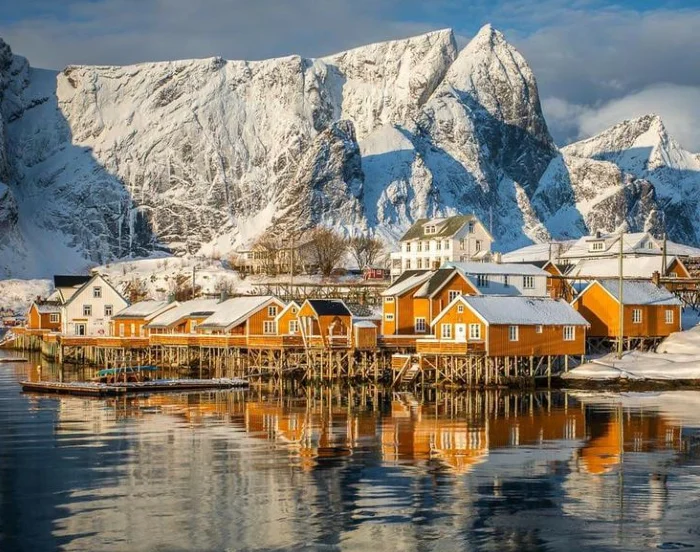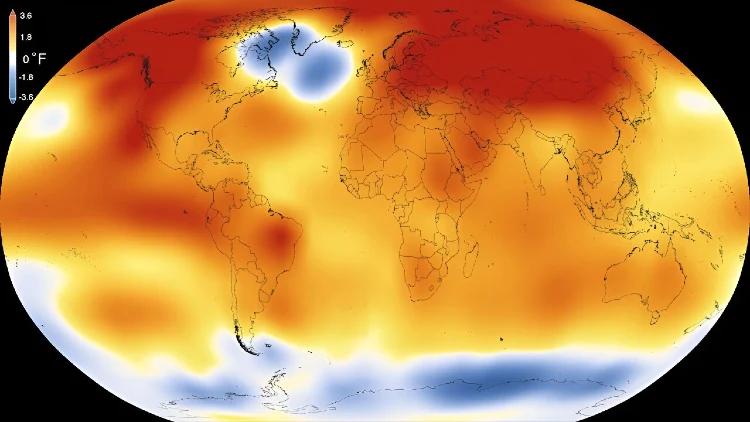The Atlantic, that vast expanse of ocean that touches many shores, is under threat – one that could send ripples of climate havoc across the globe, particularly in Europe.
Amid reports of blistering heatwaves gripping the Northern Hemisphere, a much bigger danger looms.
Recent research, published in Nature Communications, warns that the Atlantic Meridional Overturning Circulation (AMOC) might crumble within decades, possibly even sooner. This could propel European weather into wilder extremes.
Think of AMOC as a network of ocean currents in the Atlantic.
These currents ferry warm water northward, where it loses heat and then plunges deeper. This dynamic process has maintained Europe’s climate stability for thousands of years, although it’s hard to believe while sweltering through this chaotic summer.
AMOC is just a piece of the vast puzzle known as the Gulf Stream system. Much of this system is propelled by winds, which should keep blowing even if AMOC stumbles. Meaning, a portion of the Gulf Stream might endure even if AMOC falters.
However, let’s lean into the many years of research behind the relationship between Atlantic currents and climate. If AMOC falters, Europe and beyond could be hit by more climate turbulence. Even if the danger isn’t immediate, it’s a risk we should keep our eyes on.
AMOC Maintains Warmth And Stability Across Europe
AMOC’s role in the intricate balance of our world’s climate becomes evident when we consider the cozy embrace it offers to Northern Europe.
Imagine strolling through a winter in Northern Europe and feeling significantly warmer than those sharing your latitude elsewhere.
A closer look at the maps displaying how surface air temperatures differ from the average at various latitudes showcases the intricate dance of warm and cool spots across the globe:
When we focus on the northern winter, January to be precise, a crimson patch emerges west of Norway.
In this hotspot, temperatures are a staggering 20 °C higher than the average latitude temperature, courtesy of AMOC.
Similar ocean currents bestow a milder 10 °C warmth on the northeast Pacific, affecting western Canada and Alaska.
But due to prevailing westerly winds, the northwest Atlantic and northwest Pacific remain cooler, thus impacting the chill experienced in eastern Canada and Siberia.
Europe’s weather, especially Northern Europe, is a temperamental character, fluctuating from day to day, week to week, and year to year.
A tug-of-war between different air masses, warm and moist, cold and dry, plays out, often choreographed by the high-altitude jet stream. Remarkably, shifts in weather and climate can be sparked by distant events – ones unfolding over the vastness of the ocean.
The Link Between Ocean Temperatures And Weather
The recent years have brought Europe some rather unconventional weather occurrences, both during the winter and summer seasons.
As such, the North Atlantic has been displaying peculiar sea surface temperature patterns. Across extensive stretches of the ocean, from the tropics to the Arctic, temperatures have stubbornly lingered 1 °C–2 °C above or below their usual levels, sometimes for months or even years.
These patterns seem to possess a potent sway over the atmosphere, even influencing the trajectory and strength of the jet stream.
While we can partially attribute these sea surface temperature patterns to changes in AMOC, the link is more intricate than it seems.
Nevertheless, the connection between extreme seasons and weather events and unusual sea temperatures provides a glimpse into how a collapsed AMOC might disrupt the established equilibrium.
Let’s use some real-world example to better illustrate the problem:
Lofoten, Norway's Unique Warmth
Imagine a place in the Arctic Circle where winters are milder than you’d expect, a lot milder. That’s Lofoten, a corner of Norway that stays above freezing even when other Arctic areas freeze.
Lofoten, despite being so far north, enjoys a relatively warm winter. This defies the usual Arctic chill that makes this region icy and cold.

The secret behind Lofoten’s warmth is the Atlantic meridional overturning circulation (AMOC), a current system that carries warmth from lower latitudes. AMOC brings this warmth to Lofoten, making its winters milder than you’d guess.
Because of AMOC’s warm-water delivery, Lofoten stands as one of the warmest places on Earth for its latitude. This shows how ocean currents can defy expectations and bring unexpected comfort to even the chilliest places.
Lofoten’s warmth is a lesson in how our planet’s systems are interconnected. Ocean currents like AMOC can reshape climate even in the harshest places, proving that nature always has surprises in store – even in the heart of the Arctic Circle.
Northern Europe's Bitter Winters
Picture Northern Europe in the grip of severe winters, one after the other. This happened in 2009/10 and 2010/11, and scientists connected it to a temporary slowdown of the Atlantic meridional overturning circulation (AMOC).
AMOC’s Ripple Effect: The slowdown in AMOC led to these biting winters. But the story doesn’t stop there.
At the same time, the tropics were sizzling with heat. This heat buildup fueled an unusually active hurricane season from June to November in 2010. So, while Northern Europe shivered, the tropics were hit with powerful hurricanes.
This interplay between faraway regions – chilling Europe and igniting tropical storms – is a striking reminder that Earth’s systems are intricately linked. Even shifts in one part of the world can send ripples across the planet, shaping everything from weather to hurricanes.
Unruly European Weather
Imagine Europe’s weather going haywire during the winter of 2018/19. It wasn’t business as usual.
Something in the oceans stirred the pot. The Arctic faced an oddly warm winter, while the North Atlantic turned colder than expected. These bizarre sea conditions set off a chain reaction.
The jet stream – that high-altitude air current that plays weather conductor – lost its usual vigor due to these sea quirks.
With the jet stream’s weakening, cold air swept across Europe, causing the infamous “Beast from the East” cold snap.
But here’s the twist. The Arctic, usually a frozen expanse, felt warmth. It was a real head-scratcher.
This sea-to-weather connection is a reminder that Earth’s elements are like a delicate dance. Changes in one corner can lead to surprising moves in another, reshaping familiar patterns.
These examples underscore the interconnectedness of ocean temperatures and atmospheric behavior, highlighting the role AMOC plays in regulating this complex dance.
The Peculiar Rise of The Cold Blob
During the mid-2010s, a peculiar phenomenon known as the “cold blob” emerged in the North Atlantic. This chilly anomaly peaked in the summer of 2015, coinciding with heatwaves in Central Europe.
Curiously, it was one of the rare spots on the planet that remained cooler than its long-term average.
Although this cold blob initially seemed indicative of a weakened AMOC, further investigation by my colleagues and me suggested that it was more likely influenced by local atmospheric factors.

In 2017, the tropical Atlantic once again exhibited higher-than-usual temperatures, leading to another active hurricane season.
While the AMOC’s role in this scenario wasn’t as clear as in 2010, significant warmth to the northeast likely sustained Hurricane Ophelia. The storm originated near the Azores and made an unexpected landfall in Ireland in October.
Examining just these limited instances, it becomes evident that a more significant reorganization of North Atlantic surface temperatures could have far-reaching implications for the climate across Europe and beyond.
As ocean temperature extremes become more pronounced, they could reshape weather systems powered by the ocean’s heat and moisture. This alteration might intensify Atlantic storms as they gain strength from rising temperatures.
Additionally, heightened ocean temperature disparities could exert more influence on the paths of tropical hurricanes and the behavior of the jet stream, causing storms to head toward previously improbable destinations.
Should the AMOC eventually collapse, the result could be amplified extremes of heat, cold, drought, and flooding.
These diverse shifts, in turn, would aggravate the ongoing climate crisis with a spectrum of unexpected challenges.
And that’s just the beginning!
What We Can Expect If AMOC Collapses (Expert Predictions)
We crunched the numbers and asked experts to offer up some predictions of what we most likely would happen to humanity, the economy, and the environment if the Atlantic Meridional Overturning Circulation (AMOC) were to collapse:
Impact on Humans
Extreme Weather Events: The collapse of AMOC could lead to more frequent and severe weather events, such as heatwaves, cold spells, and storms. These extremes could disrupt daily life, strain infrastructure, and pose risks to public health.
Shifts in Rainfall Patterns: Changes in ocean currents could alter rainfall patterns, leading to droughts in some regions and heavy rainfall in others. This could impact agriculture, water supply, and food security.
Rising Sea Levels: The weakening of AMOC might contribute to accelerated sea level rise along certain coastlines, exacerbating coastal erosion, flooding, and threatening coastal communities.
Impact on Fisheries: Altered ocean temperatures could affect marine ecosystems and fish populations, potentially disrupting fisheries and impacting livelihoods of coastal communities that rely on fishing.
Economic Consequences
Agricultural Disruptions: Changes in weather patterns could affect crop yields and agricultural productivity. Unpredictable weather could lead to crop failures, raising concerns about food availability and prices.
Infrastructure Damage: More intense storms and rising sea levels could damage infrastructure like roads, bridges, and power plants. This could result in costly repairs and disruptions to services.
Losses in Tourism: Extreme weather events and environmental changes could deter tourists and affect tourism-dependent economies, leading to economic losses for regions relying on tourism.
More To Discover
- Shell’s $2.1 Million Legal Action Against Greenpeace Marks a Significant Escalation in Environmental Disputes
- A Common Laundry Detergent Enzyme Can Recycle Single-Use Plastics In 24-Hours, Researchers Discover
- Nurturing Georgia Peaches in a Changing Climate: Ensuring the Future of an Iconic Crop
- The Sweet Smell of Pest Control: Roses to the Rescue in Organic Farming
Environmental Impact
Ecosystem Disruption: The collapse of AMOC could disrupt marine ecosystems, affecting biodiversity and potentially leading to shifts in species distribution and abundance.
Ocean Acidification: Changes in ocean currents could impact the distribution of nutrients and carbon dioxide absorption, potentially contributing to ocean acidification and affecting marine life.
Impact on Coral Reefs: Altered ocean temperatures and currents could harm coral reefs, leading to coral bleaching and affecting the ecosystems they support.
Shifts in Ocean Circulation: The collapse of AMOC could lead to broader shifts in global ocean circulation patterns, which could have cascading effects on climate systems worldwide.
Overall, the potential consequences of an AMOC collapse are complex and far-reaching, affecting various aspects of human society, the economy, and the environment.
These potential impacts highlight the need for proactive measures to mitigate the risks associated with such a scenario and underscore the interconnectedness of the Earth’s climate systems.




















